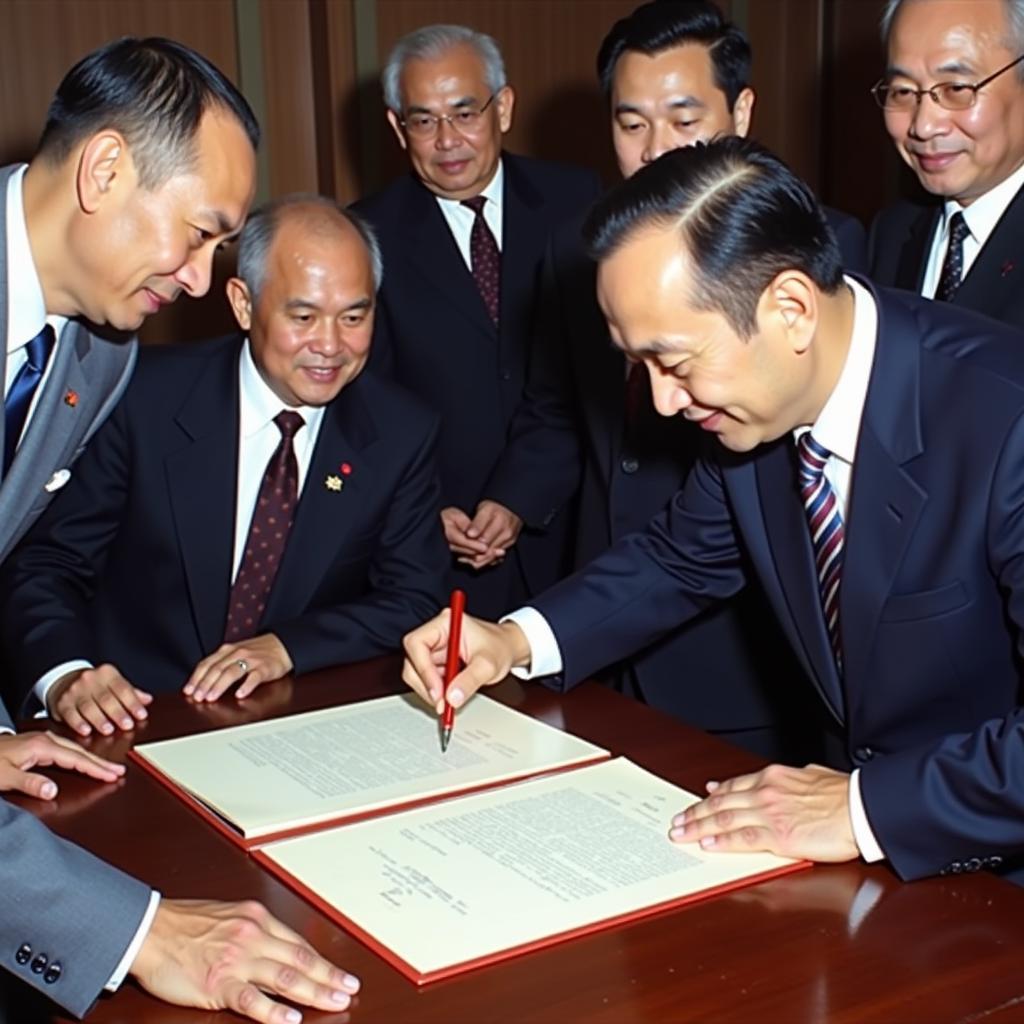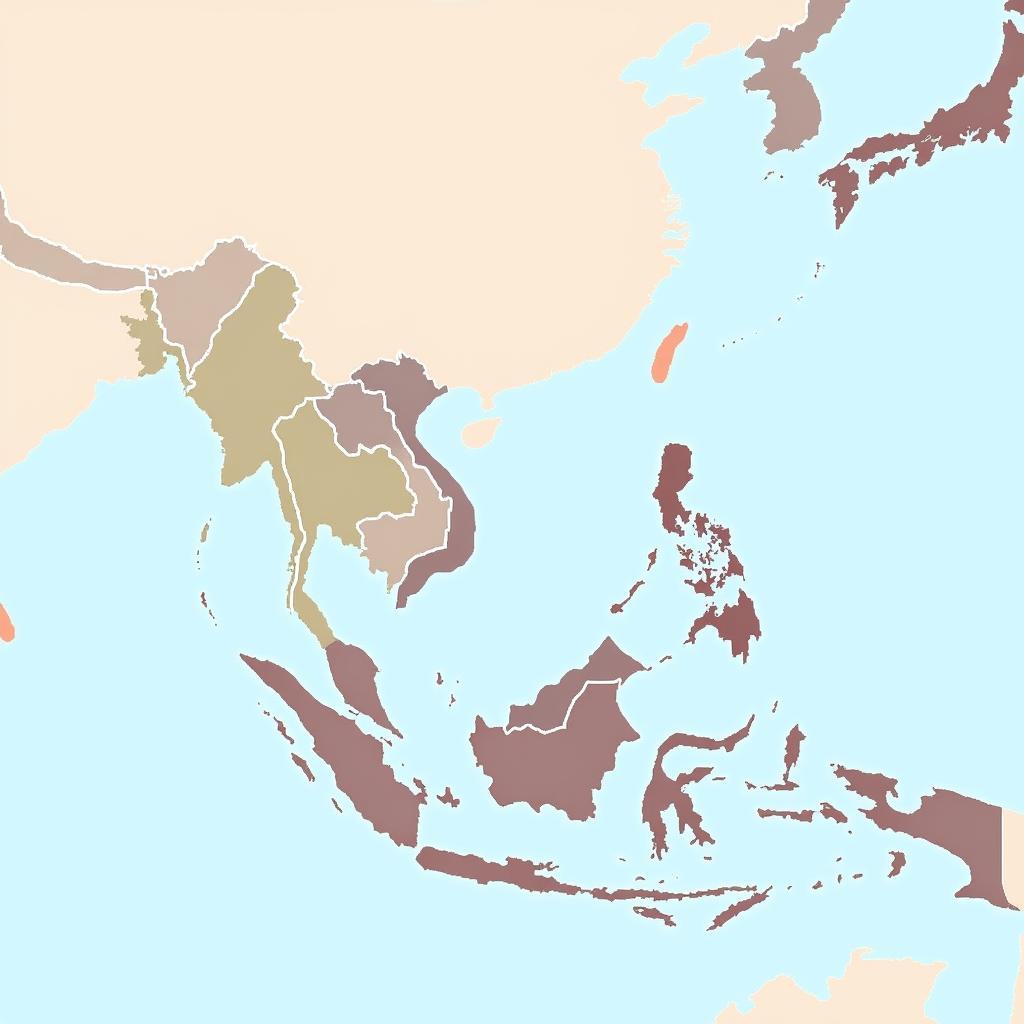Understanding the historical context behind the formation of ASEAN is crucial to appreciating its present-day relevance. “Apa Latar Belakang Terbentuknya Asean?” translates to “What is the background of the formation of ASEAN?” This question delves into the key motivations and circumstances that led to the establishment of this influential Southeast Asian organization. The answer lies in a complex interplay of political, economic, and social factors that shaped the region in the mid-20th century.
The Seeds of ASEAN: Post-Colonial Struggles and Regional Instability
The newly independent nations of Southeast Asia faced numerous challenges in the aftermath of World War II and the subsequent struggles for independence. These included internal conflicts, communist insurgencies, and lingering tensions with former colonial powers. The region was a hotbed of instability, fraught with political divisions and economic uncertainties. This volatile environment underscored the need for regional cooperation to address shared concerns and promote stability.
The formation of ASEAN was not a spontaneous event but rather a culmination of several earlier attempts at regional collaboration. Organizations like the Association of Southeast Asia (ASA), Maphilindo, and the Southeast Asia Treaty Organization (SEATO) laid the groundwork for closer ties, although they ultimately fell short of achieving lasting regional integration due to conflicting national interests and external pressures. These early endeavors, however, highlighted the growing recognition of the potential benefits of regional cooperation.
The Bangkok Declaration: A Foundation for Peace and Prosperity
On August 8, 1967, five Southeast Asian nations – Indonesia, Malaysia, the Philippines, Singapore, and Thailand – signed the Bangkok Declaration, marking the official birth of ASEAN. This pivotal document articulated the shared vision of a peaceful and prosperous Southeast Asia, based on principles of mutual respect, cooperation, and non-interference in internal affairs. The declaration addressed the pressing need for regional stability, economic development, social progress, and cultural advancement. It emphasized the importance of collaboration in areas such as trade, education, and cultural exchange.
 ASEAN Founding Fathers Signing the Bangkok Declaration
ASEAN Founding Fathers Signing the Bangkok Declaration
Key Motivations Behind ASEAN’s Formation: Addressing Shared Challenges
Several key factors contributed to the formation of ASEAN. The Cold War and the looming threat of communism played a significant role, as did the desire to prevent the region from becoming a battleground for competing superpowers. The nascent nations also recognized the potential for economic growth and development through regional cooperation. By pooling resources and expertise, they aimed to accelerate economic progress and improve living standards. Furthermore, the desire to promote regional stability and resolve disputes peacefully was a driving force behind the creation of ASEAN.
The Cold War Context: A Catalyst for Regional Unity
The Cold War backdrop significantly influenced the formation of ASEAN. The fear of communist expansion and the desire to maintain regional neutrality prompted the founding members to seek strength in unity. This shared concern provided a powerful impetus for closer cooperation and the establishment of a regional platform for dialogue and collaboration.
Economic Cooperation: A Pathway to Shared Prosperity
The potential for economic growth through regional cooperation was another crucial factor. The founding members recognized the benefits of increased trade, investment, and technological exchange. They envisioned ASEAN as a vehicle for promoting economic development and improving the living standards of their citizens.
 Chart illustrating ASEAN Economic Growth
Chart illustrating ASEAN Economic Growth
Promoting Peace and Stability: A Cornerstone of ASEAN’s Mission
The desire to promote regional peace and stability was a fundamental motivation behind ASEAN’s formation. The founding members sought to establish mechanisms for peaceful conflict resolution and prevent the escalation of tensions between member states. This commitment to peaceful coexistence remains a core principle of ASEAN’s charter.
What Were the Circumstances Leading to the Formation of ASEAN?
The circumstances leading to the formation of ASEAN were complex and multifaceted. The post-colonial era brought both opportunities and challenges for the newly independent nations of Southeast Asia. These nations were eager to forge their own paths and establish themselves on the world stage. However, they also faced internal and external threats that jeopardized their stability and development. ASEAN emerged as a response to these challenges, providing a framework for regional cooperation and a platform for addressing shared concerns.
Dr. Kusuma Sjadarma, a prominent Southeast Asian historian, offers this perspective:
“The formation of ASEAN was a pivotal moment in the history of Southeast Asia. It represented a collective effort by the region’s nations to overcome their differences and work together towards a common future. The challenges they faced were immense, but their determination to build a better future for their people ultimately prevailed.”
 Map of Southeast Asia with ASEAN Member States Highlighted
Map of Southeast Asia with ASEAN Member States Highlighted
Conclusion: ASEAN’s Enduring Legacy
The question “apa latar belakang terbentuknya ASEAN?” offers valuable insights into the organization’s origins and its enduring relevance. The formation of ASEAN was a response to the unique historical circumstances and challenges faced by the region in the mid-20th century. The desire for peace, stability, and economic prosperity drove the founding members to create a platform for regional cooperation. Today, ASEAN continues to play a vital role in shaping the political, economic, and social landscape of Southeast Asia, demonstrating the enduring power of collaboration and shared vision. The organization’s continued success hinges on its ability to adapt to evolving challenges and remain a relevant force for positive change in the region.
FAQ
- What does “apa latar belakang terbentuknya ASEAN” mean? It means “what is the background of the formation of ASEAN?”
- When was ASEAN formed? ASEAN was formed on August 8, 1967.
- What were the main goals of ASEAN’s founders? The main goals were peace, stability, and economic prosperity.
- How did the Cold War influence the formation of ASEAN? The Cold War created a sense of urgency for regional unity against communist expansion.
- What was the Bangkok Declaration? It was the founding document of ASEAN.
- How many founding members did ASEAN have? ASEAN had five founding members.
- What is ASEAN’s role today? ASEAN continues to promote regional cooperation and address shared challenges.
Related Questions and Articles
- What are the current challenges facing ASEAN?
- How has ASEAN contributed to economic development in Southeast Asia?
- What is the future of ASEAN?
Contact us for further assistance: Phone: 0369020373, Email: [email protected]. Our address is: Thon Ngoc Lien, Hiep Hoa, Bac Giang, Vietnam. We have a 24/7 customer support team.


